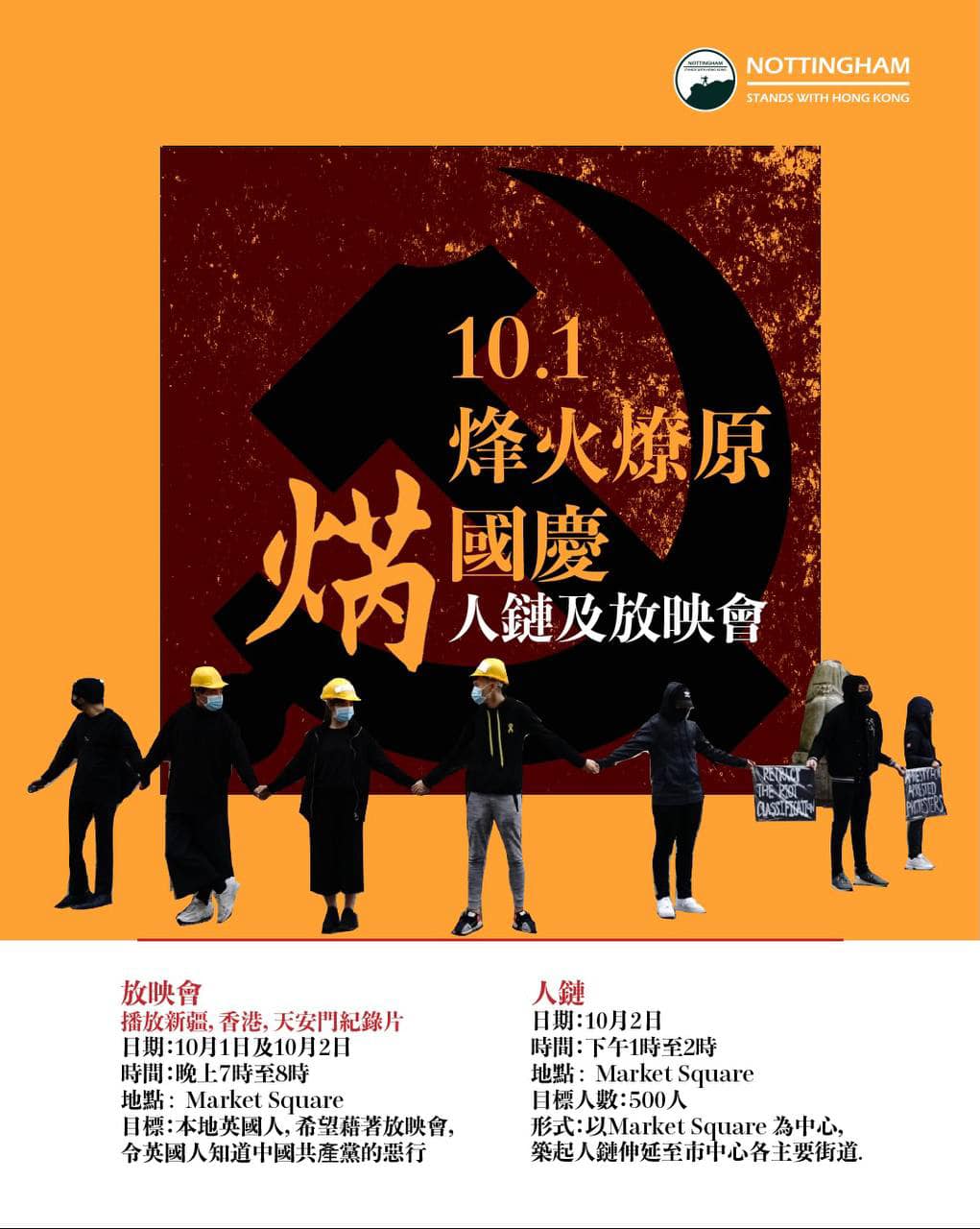A poster with an uncommon character denoting a common Cantonese word
« previous post | next post »
From Facebook:
Transcription of the slogan:
烽火燎原焫國慶 fung1 fo2 liu4 jyun4 naat3 gwok3 hing3
人鏈及放映會 jan4 lin2 kap6 fong3 jing2 wui2*
*Jyutping transcribes 會 as wui6 but some say that it should be wui2
The English version of the poster (available via the Facebook account linked above) gives this rendering:
Ignite The Beacon and Fight Against CCP
Human Chain and Documentary Screening
The large, uncommon character to the left is 焫. It is not among the top 9,933 characters on this list. The Cantonese pronunciation is naat3; the Mandarin pronunciation is ruò, but it is not regularly used in written Mandarin. In Cantonese it means:
[1] [v] scald; burn; sear
[2] [adj] boiling hot; scalding
Lexemes that include this character:
焫雞 naat3 gai1 = a soldering iron, an electric soldering iron
焫㷫 naat3 hing3 ruo4 qing4 = to enrage; to aggravate; to anger
焫嚫 naat3 can1 ruo4 qin1 = get burned; to get scalded
㷫過焫雞 hing3 gwo3 naat3 gai1 = in a rage
Example of usage:
keoi5 zek3 sau2 bei2 gwan2 seoi2 naat3 can1
佢隻手俾滾水焫嚫
The hot water scalded his hand.
[Lit. his [counter] hand by boiling-water scald-[bad effect]]
(source for the above, all of which are Cantonese, not Mandarin)
Entry from Wiktionary:
Etymology 1
Pronunciation
| trad. | 焫 | |
|---|---|---|
| simp. # | 焫 | |
-
-
- (Baxter–Sagart): /*not/
- (Zhengzhang): /*njod/
-
Definitions
焫
Etymology 2
Compare Zhuang ndat (“hot”), Thai เดือด (dʉ̀ʉat, “to boil”).
Pronunciation
| trad. | 焫 | |
|---|---|---|
| simp. # | 焫 | |
| alternative forms | 烙 辣 㶧 |
|
-
- Cantonese
- (Guangzhou, Jyutping): naat3
- (Taishan, Wiktionary): nat1
- Hakka (Meixian, Guangdong): nad5
- Cantonese
Definitions
焫
-
- (Cantonese, Hakka) (of hot objects) to burn; to scald; to sear
- (Cantonese, Hakka) very hot; scalding
Lessons to be learned:
A morpheme that is common in one Sinitic language or topolect may be missing in other Sinitic languages and topolects. Currently, the prestige language is Modern Standard Mandarin (Pǔtōnghuà 普通话), which forms the basis for written Chinese (Zhōngwén 中文). This causes a scramble for characters to write morphemes that are missing in the standard written language and results in a mismatch between the character sets used to write the standard written language and those used to write the other Sinitic languages. As we have seen in numerous Language Log posts and elsewhere, throughout history morphemes from a wide variety of sources (both Sinitic and extra-Sinitic) have been incorporated in the total inventory of morphemes employed in Sinitic speech and writing. In the study of Sinitic languages and Chinese writing, one must be constantly attentive to all of these nuances and niceties.
Selected readings
- "Better said in Cantonese" (7/4/20) — with a long bibliography of relevant posts
- "Cantonese 'here'" (10/15/15)
- "The future of Cantonese, part 2" (6/10/18) — special Cantonese characters (in the comments here)
[Thanks to apoemyoudontforget]

Claw said,
October 4, 2021 @ 11:39 am
Due to initial n-/l- free variation in Cantonese, it's more often pronounced laat3 rather than naat3, especially in Hong Kong, possibly due to conflation with 辣 (laat6, meaning "spicy"), and indeed many people write this word as 辣 because of 焫's relative obscurity as a character.
Victor Mair said,
October 4, 2021 @ 2:51 pm
"…many people write this word as 辣 because of 焫's relative obscurity as a character."
Further confusing the semantic and morphological identity of the Cantonese word. At least 焫 has the "fire" radical.